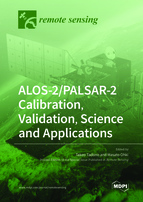ALOS-2/PALSAR-2 Calibration, Validation, Science and Applications
A special issue of Remote Sensing (ISSN 2072-4292). This special issue belongs to the section "Satellite Missions for Earth and Planetary Exploration".
Deadline for manuscript submissions: closed (28 February 2022) | Viewed by 35283
Special Issue Editors
Interests: SAR; optical instrument; calibration; validation; hydrology; disaster; forest and ecosystem; photogrammetry
Special Issues, Collections and Topics in MDPI journals
Special Issue Information
Dear Colleagues,
The Advanced Land Observing Satellite-2 (ALOS-2, nicknamed "DAICHI-2") was launched on May 24th, 2014, which is a follow-on mission of L-band Synthetic Aperture Radars (SARs) by the ALOS "DAICHI" from 2006 to 2011, and the Japanese Earth Resources Satellite-1 (JERS-1, “FUYO-1”) from 1992 to 1998. Thus, global coverage and almost three decades of L-band SAR data are currently available. In addition, ALOS-4 is under development and will be launched in the Japanese Fiscal Year 2022 as a successor to Japanese L-band SAR missions.
The mission objectives of ALOS-2 that were defined to fulfill social needs include the following: 1) disaster monitoring of damaged areas, both in considerable detail and when these areas may be large, 2) continuous updating of data archives related to national land and infrastructure information, 3) effective monitoring of cultivated areas, and 4) global monitoring of tropical rain forests to identify carbon sinks. The Phased Array-type L-band SAR-2 (PALSAR-2) mounted on ALOS-2 has capabilities of high-resolution, wide-swath width and both right and left looking observations, and is now operating globally to achieve these objectives. The Japan Aerospace Exploration Agency (JAXA) is continuously conducting research announcement (RA) programs that provide opportunities to use PALSAR-2 and other satellite data to engage and enhance science and application activities worldwide.
This Special Issue solicits original manuscripts on calibration, validation, science, and applications based on PALSAR-2 data. The potential topics of this Special Issue include, but are not limited to, the following:
- Calibration related issues and achievements of PALSAR-2
- Polarimetry and interferometry related processing and analysis
- Scientific and application analysis in various fields
- Data fusion technics and new products, e.g., analysis-ready data
We also invite submissions from principal investigators (PIs) of the ALOS-2 RA programs.
Dr. Takeo Tadono
Dr. Masato Ohki
Guest Editors
Manuscript Submission Information
Manuscripts should be submitted online at www.mdpi.com by registering and logging in to this website. Once you are registered, click here to go to the submission form. Manuscripts can be submitted until the deadline. All submissions that pass pre-check are peer-reviewed. Accepted papers will be published continuously in the journal (as soon as accepted) and will be listed together on the special issue website. Research articles, review articles as well as short communications are invited. For planned papers, a title and short abstract (about 100 words) can be sent to the Editorial Office for announcement on this website.
Submitted manuscripts should not have been published previously, nor be under consideration for publication elsewhere (except conference proceedings papers). All manuscripts are thoroughly refereed through a single-blind peer-review process. A guide for authors and other relevant information for submission of manuscripts is available on the Instructions for Authors page. Remote Sensing is an international peer-reviewed open access semimonthly journal published by MDPI.
Please visit the Instructions for Authors page before submitting a manuscript. The Article Processing Charge (APC) for publication in this open access journal is 2700 CHF (Swiss Francs). Submitted papers should be well formatted and use good English. Authors may use MDPI's English editing service prior to publication or during author revisions.
Keywords
- ALOS-2 and PALSAR-2
- L-band SAR
- Calibration
- PolSAR, InSAR, PolInSAR, and coherence analysis
- Disasters monitoring
- Forest, vegetation, and ecosystem
- Hydrology
- Agriculture
- Snow and ice
- Ocean applications
- Time-series analysis
- Data fusion analysis






